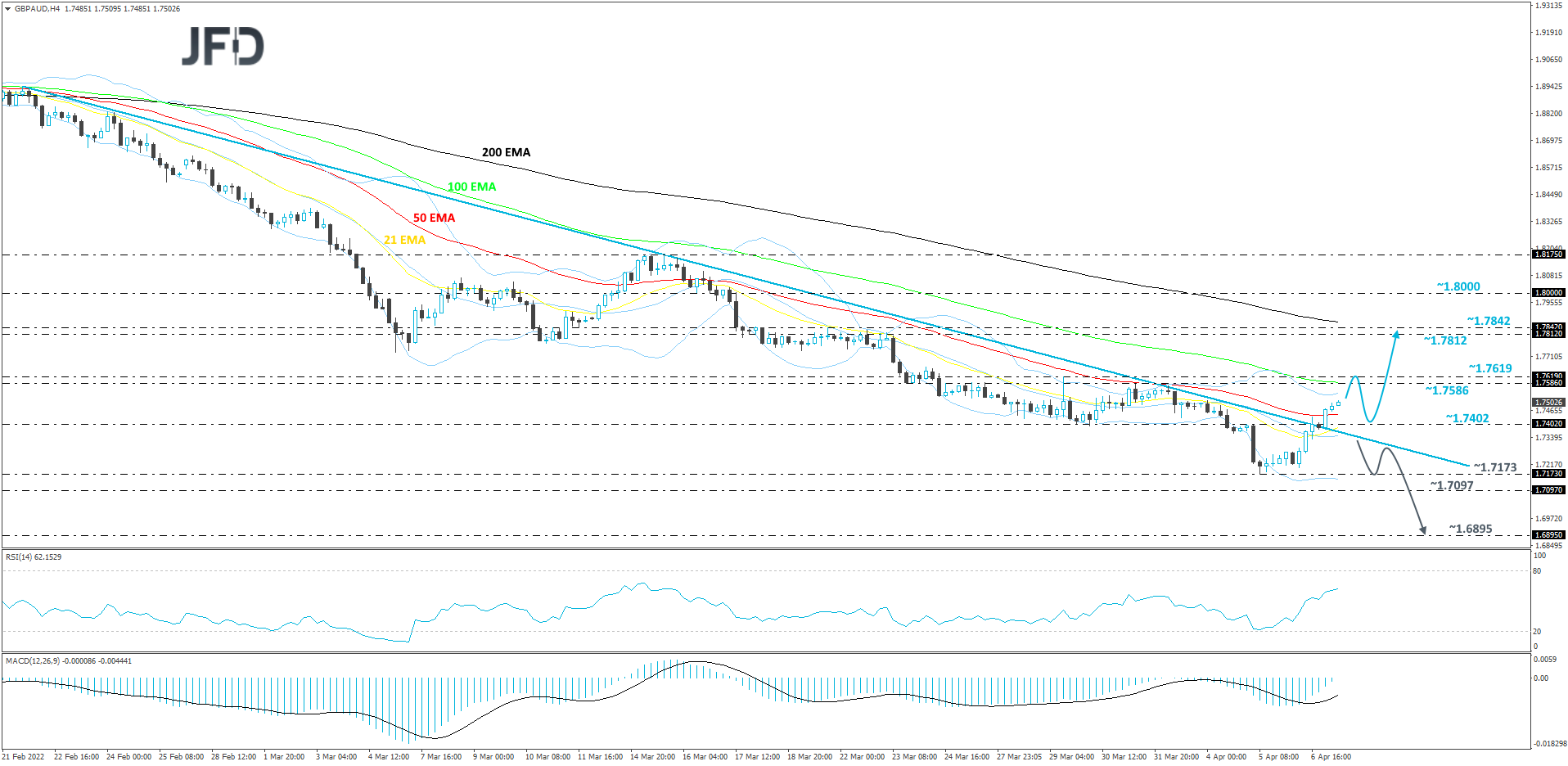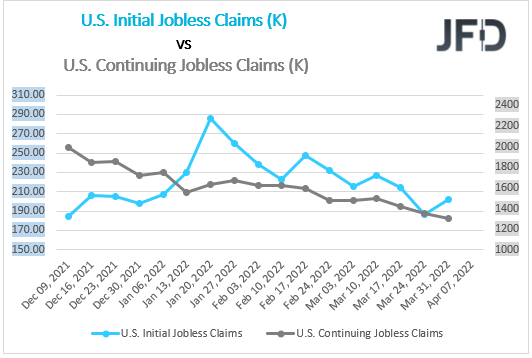Yesterday, the FOMC released the minutes from its March meeting. USD rallied, pushing commodity-linked currencies lower. The US initial and continuing jobless claims will be on the lookout.
FOMC Meeting Minutes Scared Off Some Buyers
Yesterday, the FOMC released the minutes from its March meeting. The minutes revealed that the FOMC members favor tightening the monetary policy at an even faster pace, supporting the rate hike by 50 bps during the next meeting in May.
If that’s the case, this will place the target rate between 0.75% and 1.00%. After the minutes were released, the US indices dived again after recovering some of the losses made at the beginning of the trading session yesterday. The Dow Jones index lost around 0.42%, the S&P 500 finished with a 0.97% loss and the NASDAQ wiped off around 2.22%.
Among the major currencies, the U.S. dollar was once again the top gainer, followed by GBP and EUR. The biggest losers were the commodity-linked currencies, such as AUD, NZD, and CAD.
USD/CHF – Technical Outlook
After USD/CHF broke and stayed above a short-term tentative downside resistance line taken from the high of Mar. 16, more traders might have taken a liking of the pair to the upside. Even though the rate could correct lower, as long as it stays above that downside line and the short-term tentative upside support line, taken from the low of Mar. 31, we will continue aiming higher.
A strong rebound from the aforementioned downside line, or the 0.9304 hurdle, marked by the low of Apr. 6, may attract more buyers into the game, potentially sending USD/CHF towards the current high of this week at 0.9350. If that barrier surrenders, this will confirm a forthcoming higher high, clearing the way towards the next possible resistance area between the 0.9381 and 0.9388 levels, marked by the high of Mar. 28 and the inside swing low of Mar. 16.
To shift our attention to some lower areas, we would prefer to wait for a break below the previously discussed upside line. This way, the pair may fall to the 0.9237 hurdle, marked by the low of Apr. 5, where a temporary hold-up could occur. If the slide continues, USD/CHF could travel to the 0.9220 obstacle or to the 0.9195 level, marked by the low of Mar. 31.

Natural Gas Continues To Take The Spotlight
In the commodity world, natural gas continued to take the spotlight as its price continued to rise. This is due to the probability that the EU may partially ban Russian gas imports. That said, yesterday, Italy’s Mario Draghi came out saying,
“The gas embargo is not on the table, and I don't know if it ever will be."
This is understandable because although this could put financial pressure on Gazprom (OTC:OGZRY) and the Russian government, this would also have a knock-on effect on the European countries. Because there are currently no cheap alternatives to Russian gas, buying it from somewhere else puts a huge burden on the EU economies.
The US is undoubtedly benefiting from the situation, as it increased its LNG shipments to Europe to cover the possible shortages of Russian gas. The main destination countries are France, Spain, and the United Kingdom. The EU could try and make a deal with Iran. However, the US embargos on Iran create obstacles for any potential deal between the EU and Iran.
European Data Is In Focus
In the early hours of the European morning, Switzerland delivered its unemployment rate figures, both seasonally adjusted (s.a.) and non-seasonally adjusted (n.s.a.). The current forecast for the s.a. number is for it to stay the same as previous, at +2.2%, and for the n.s.a. figure also to remain at +2.5%.

Germany threw out their MoM industrial production figure for March, which was expected to decline significantly, from +2.7% to -0.2%. However, the actual number showed better than the forecast, at +0.2%.
According to the Halifax Bank of Scotland, the United Kingdom has shown us how the prices in their housing market changed over the past month, which is one of the largest mortgage lenders in the UK. The expectation was for the YoY reading to drop slightly, from +10.8% to +10.4%, but the actual figure came out at +11.0%.
GBP/AUD – Technical Outlook
Yesterday, GBP/AUD managed to finally break and stay above a short-term downside resistance line taken from the high of Feb. 21. The pair is now seen slowly grinding higher, and as long as it remains above that downside line, we will continue aiming higher.
A further push north could bring the rate to its next potential resistance area, between the 1.7586 and 1.7619 hurdle, marked by the highs of Mar. 31 and 29, respectively. However, if that area fails to hold, its break may lead GBP/AUD towards the zone between the 1.7812 and 1.7842 levels, marked near the highs of March 23rd and 21st, respectively. Around there, the pair might also test the 200 EMA.
Alternatively, if the rate falls below the aforementioned downside line, this may temporarily spook the bulls from the field. GBP/AUD could fall to the 1.7173 hurdle, marked by the current lowest point of April. If that hurdle breaks, this will confirm a forthcoming lower low, possibly sending GBP/AUD towards the 1.7097 obstacle or even to the 1.6895 level, marked by the lowest point of November 2017.
The Eurozone came out with its MoM and YoY retail sales numbers for February. The MoM one came out at 0.3%, whereas the YoY figure was 5%. Also, the ECB will publish the account of monetary policy from its previous meeting held in March.
As For The Rest Of Today’s Events
The U.S. will be releasing its initial and continuing jobless claims. The initial claims are forecasted to have dropped just slightly, from 202k to 200k. The continuing one is also expected to fall slightly from 1307k to 1302k.

